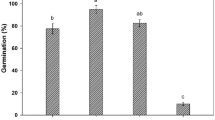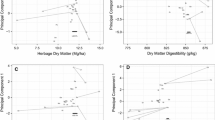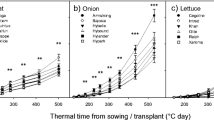Summary
Lolium perenne, cultivar New Zealand Mother was grown in sand pot culture in a controlled-environment cabinet. Three nitrogen treatments, two water levels and two light intensities were applied in factorial arrangement and the plants were harvested at 33, 46, and 60 days from germination. The responses of dry weight, tiller number, and leaf area to the treatments were examined.
The treatment effects on total leaf area at the final harvest were related to variation in both tiller number and the size of new and expanded leaves. There were no effects on the average number of either new or expanded leaves per tiller.
Variation in total dry weight at the final harvest was related to treatment effects on both tiller number and the mean dry weight per tiller. Tiller weight increased with higher light intensity and higher water level, but decreased with added nitrogen. The relative distribution of dry matter between leaves, sheaths and roots was greatly influenced by the treatments.
Tillering responded markedly to change in light intensity, nitrogen and water supply, and variation in tiller number was the major morphological response of perennial ryegrass associated with variation in total dry weight and leaf area.
Similar content being viewed by others
References
Denmead, O. T. and Shaw, R. H., The effects of soil moisture stress at different stages of growth on the development and yield of corn. Agron. J.52, 272–74 (1960).
Gaastra, P., Photosynthesis of crop plants as influenced by light, carbon dioxide, temperature and stomatal diffusion resistance. Meded. Landbouwhogeschool Wageningen59, 1–68 (1959).
Hewitt, E. J., Sand and water culture methods used in the study of plant nutrition. Tech. Commun. No.22, Comm. Bur. Hort. and Plantation Crops, Kent (1952).
Khalil, M. S. H., The inter-relation between growth and development of wheat as influenced by temperature, light and nitrogen. Thesis for Degree of Doctor of Agrarian Sciences, Agricultural University, Wageningen (1956).
Langer, R. H. M., Growth and nutrition of timothy. V. Growth and flowering at different levels of nitrogen. Ann. Applied Biol.47, (4) 740–751 (1959).
Langer, R. H. M., Tillering in herbage grasses. Herbage Abstr.33, (3) 141–8 (1963).
Mitchell, K. J., Influence of light and temperature on the growth of rye grass (Lolium spp.). I. Pattern of vegetative development. Physiol. Plantarum6, 21–46 (1953).
Author information
Authors and Affiliations
Rights and permissions
About this article
Cite this article
Luxmoore, R.J., Millington, R.J. Growth of perennial ryegrass (Lolium perenne L.) in relation to water, nitrogen, and light intensity. Plant Soil 34, 269–281 (1971). https://doi.org/10.1007/BF01372784
Received:
Issue Date:
DOI: https://doi.org/10.1007/BF01372784




